Rose Ash
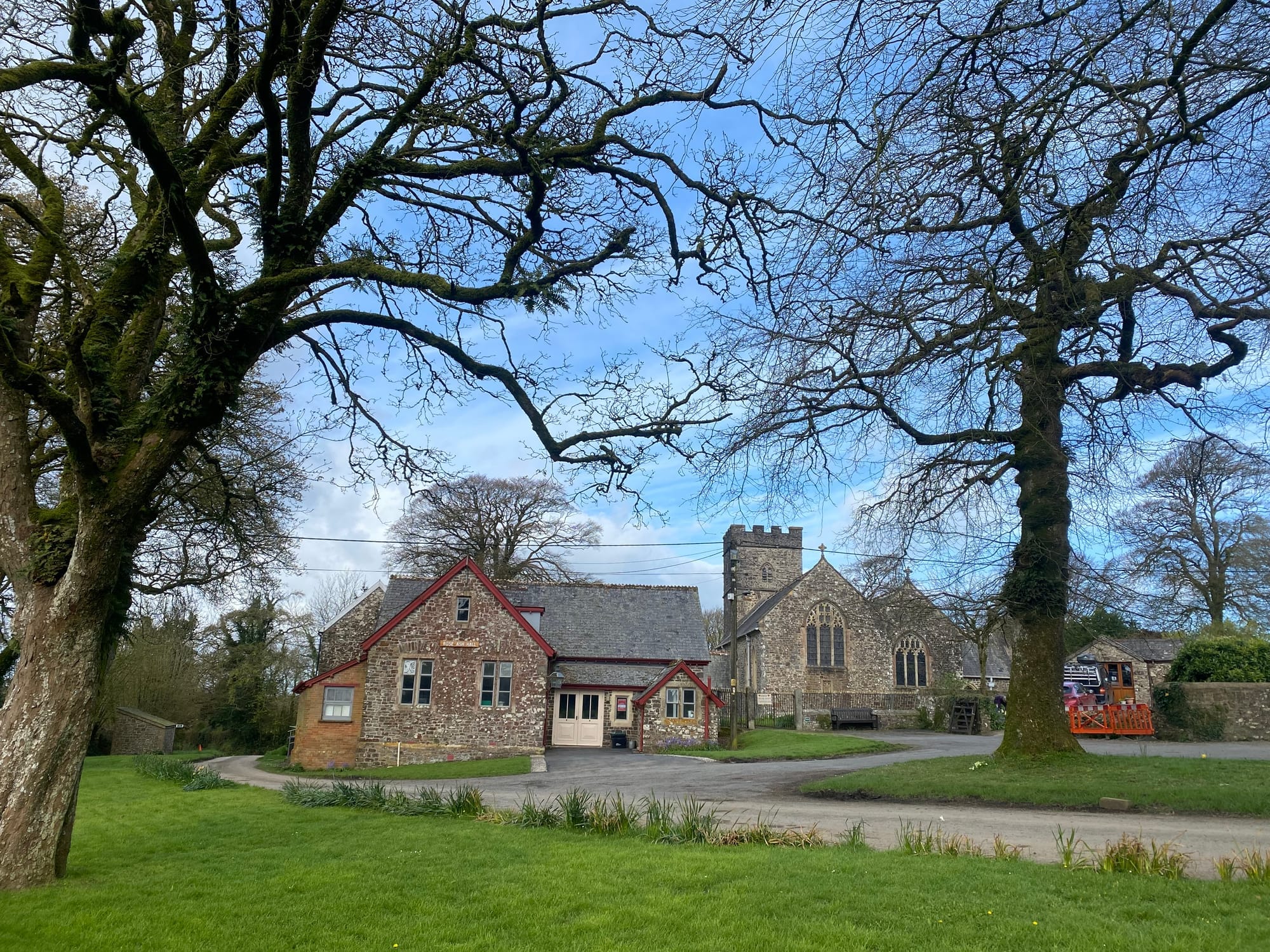
The village stands 6 miles East South East of the market town of South Molton and was formerly called Ralph-Esse. The parish contains the hamlets of Yard and part of Ash Mill.
Although Rose Ash is small, with no shop or public house, it has a vibrant community that revolves around the beautiful church of St Peter and the Village Hall. The Village Hall is very well equipped and is used widely by the community. It is available to book for private functions.
The village is set amongst beautiful scenery with stunning views across much of the surrounding countryside.
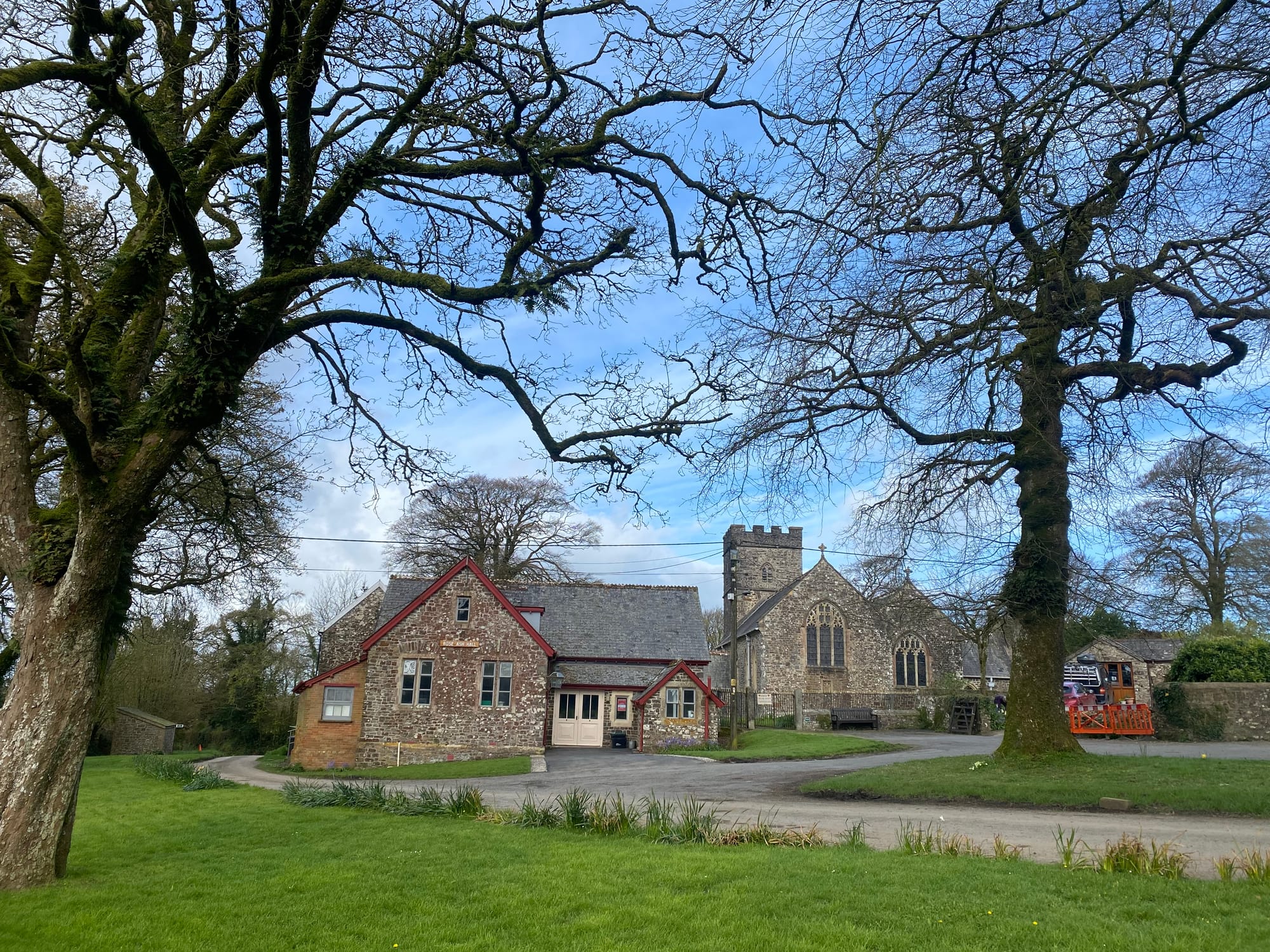
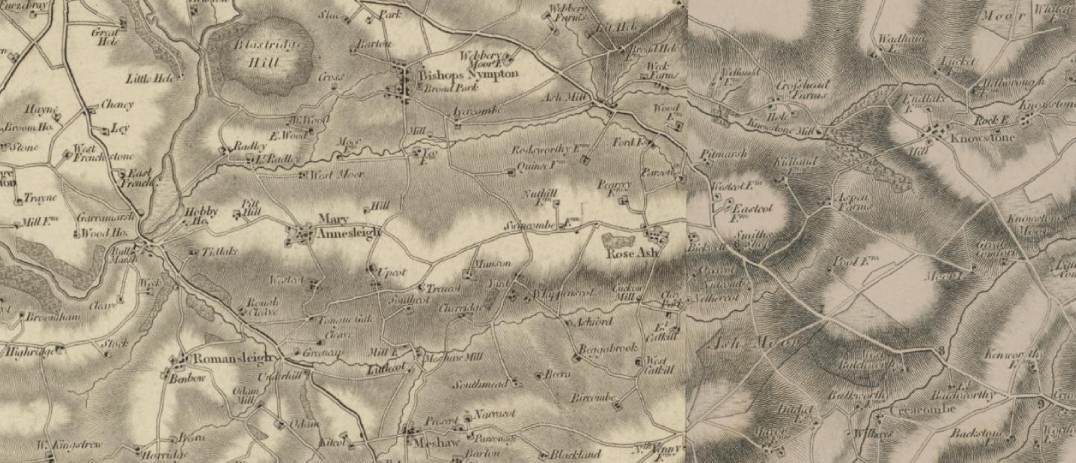
From Loosemore of Devon
Rose Ash parish, extending to 5082 acres immediately to the west of Creacombe, lies on the back of a long ridge, nearly 800 ft. high, which is traversed by a prehistoric ridgeway. Much of the parish is wild, moory ground from which, on a clear day, there are superb views of Exmoor to the north, Dartmoor to the south. The name is sometimes said, rather fancifully, to be a corrupt form of Sir Ralfe de Esse, lord of the manor tempus Henry III (1216-1272), whose lady’s name was Rose, hence from Ralfe (or Rose)-Esse to Rose Ash. [3] In truth the name is derived from the two Domesday manors from which it was formed, viz. Aissa (Ash, later Aishe Rafe, or Rose Ash) on which lived 20 villeins, 12 bordars and 8 serfs, and the smaller Hierda (Yard-Cole) with 8 villeins, 4 bordars and 5 serfs. [4] The Yard family owned their manor continuously from 1270 to 1630, while eight generations of the Southcomb family were Rectors of the parish, in a single sequence from 1675-1948. [5]
Nowadays Rose Ash ‘town’ is a small group of houses close to the church, without shop or inn, while Yard is a cluster of 10 small houses. Most people still live in isolated homesteads, as they have done for the past 900 years or so. An estimate of the parish population since the Domesday Survey has ranged from 164-199 in 1086 to a peak of 587 in 1851, declining to 268 in 1961 and 271 in 1971.
When Domesday Book was compiled Aissa was a manor in the hundred of Witric, held by Ansger under Baldwin the Sheriff, son of Gilbert, Earl of Brion. The name is old English, from the Saxon ocsc (ash), and is probably of Norse origin, the ash tree having been held in great veneration and superstitious awe by the early races of the North.
The orthography of the name has undei^one many changes. In Bishop Bronescombe's time it was Esse Ralph. In Bishop Grandisson's Esse Raufe. In Bishop Stafford's Aysch Raff and Esseraufe. There is a record of a chapel in the manse of William Lane of Rowesassche having been licensed on May 25th, 1400. It has also been written Ash Rafe. In the King's Book of 1535 it is named Esraffee, alias Rose Ash. In Churchwardens* Account Book, 1689, Roseash; but from 1700 to 1791 it was Rose Aish. It is now known as Rose Ash.
Owners of the farms in 1900
Rodsworthy - Mr. Keats.
Bulkworthy and South Meadow - Mr. F. Adams.
Kewhouse, Nettleford, and Ditchett - Mrs. Norrish.
Foadmarsh - Mr. H. Ayre.
Kimmings - The Family of Mr. G. Ayre.
Woodhills - Mr. F. A. Veysey.
Woods - Mr. G. H. Southcomb.
Eastercott, Pearshay, or Pearcey Westacott, Whippencott, & W. Ford - Rev H G Southcomb.
Swincombe and Nutshill - Mr. Varley.
Bigbrook - Mr. R. Davy.
Cherridge - Lord Portsmouth.
West Gentry and North Yarde - Mr. Watkins.
West Quince and Munson - Miss Emily Southcomb.
Burcombe - Mr. Fry.
South Yarde - The Rev. J. H. Hosegood.
East Kimmings - The Misses Loosemore.
Nethercott & East Catkin, or Cathinge - Mr. H. Tanner.
Overcott - J. A. F. Loosmore.
Higher and Lower Ashtown - Mr. J. F. Wilkins, j.p.
East Quince and West Catkill - Mr. L. Tanner.
Heath - The Representatives of Captain Keats.
Beera - The Rev. A. F. De Gex.
North and South Vinney - Mr Pope
Middledown and Maire - Miss Benson
East Ford - Mr W Vicary
Densdon, or Danson - Mr Rew
Severy and Westcombe - The Rev. H. Toms
Willheys - Mr. Partridge.
North Grindon - Mrs Abbot
Bickwell - Mr. Wm. Ayre.
New Meadow - Mr. Babbagge
From the Devonshire Domesday vol. L,


" Baldwin has a manor called Aissa, which Seward held on the day on which King Edward was alive and dead, and it rendered Geld for one hide and one virgate. These can be ploughed by eighteen ploughs. Ansger holds these of Baldwin. Of these Ansger has in demesne one virgate and four ploughs, and the villeins have one hide and ten ploughs. There Ansger has twenty villeins and twelve bordars and eight serfs, and thirty head of cattle, and six swine, and eighty sheep, and one hundred and fifty acres of wood and sixty acres of meadow, and pasture half a leuga in length and half a leuga in breadth, and it is worth yearly one hundred shillings, and when Baldwin received it sixty shillings."
ROSE ASH - THE PROTESTATION RETURN OF 1641/2
Declaration of loyalty to Charles 1
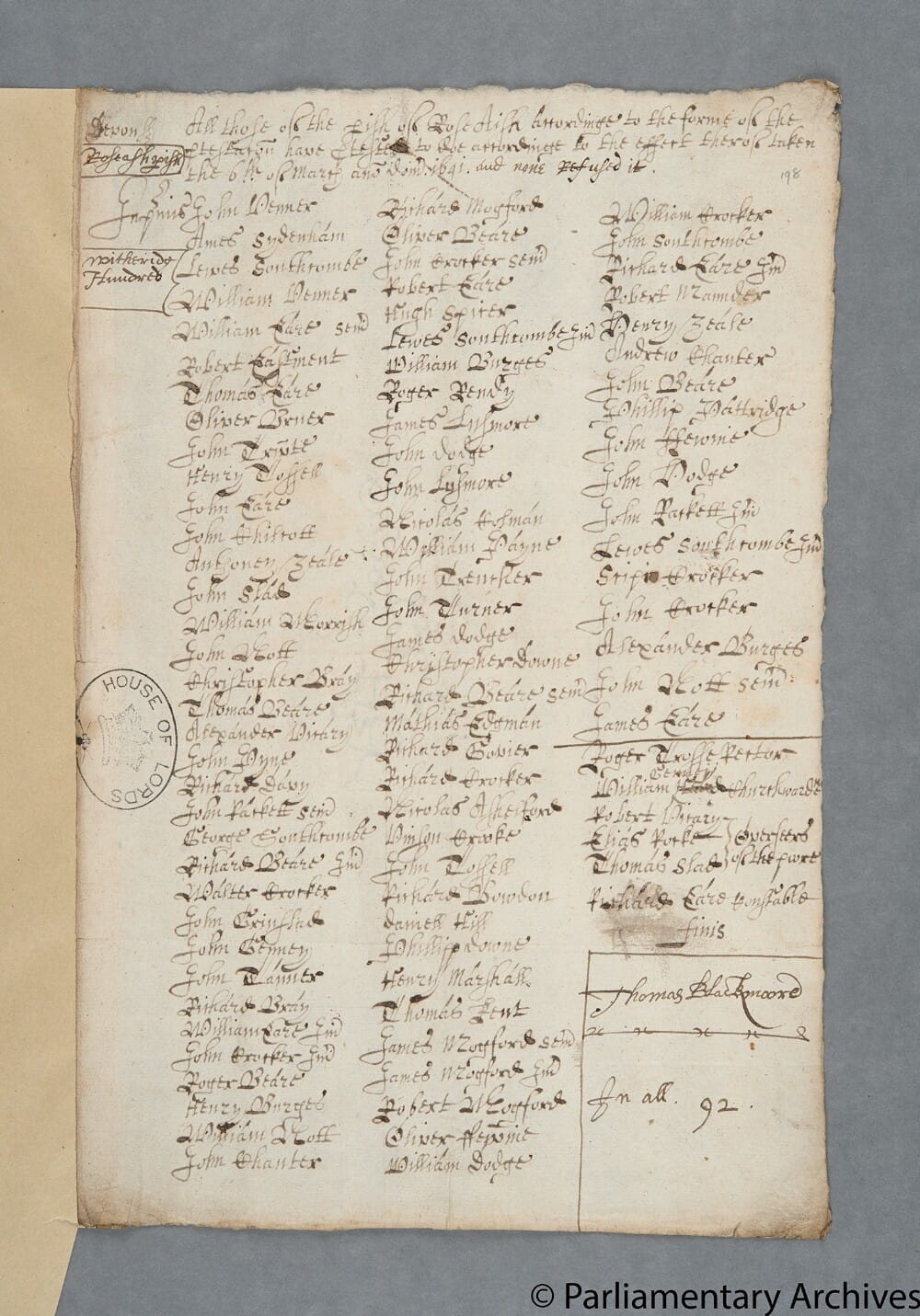
| Nicholas Ashelford | John Dodge | Robert Mogford |
| John Beare | John Dodge | William Morrish |
| Oliver Beare | William Dodge | John Nott sen. |
| Richard Beare sen. | Christopher Downe | John Nott |
| Richard Beare jun. | Philip Downe | Philip Partridge |
| Roger Beare | James Eare | William Payne |
| Thomas Beare | John Eare | John Lyne |
| Richard Bowdon | Richard Eare jun. | John Rackett jun. |
| Christopher Bray | Robert Eare | Roger Rendy |
| Richard Bray | Thomas Eare | John Slad |
| Oliver Bruer | William Eare sen. | George Southcombe |
| Alexander Burges | William Eare jun. | John Southcombe |
| Henry Burges | Roger Eastment | Lewis Southcombe |
| William Burges | Mathias Edgman | Lewis Southcombe jun |
| Andrew Chanter | John Fewine | Lewis Southcombe jun. |
| John Chanter | Oliver Fewine | Hugh Spicer |
| John Chiscott | John Genney | Amos Sydenham |
| Nicholas Cosman | Richard Govier | John Tanner |
| John Crocker sen. | John Grinslad | Henry Tossell |
| John Crocker jun. | Daniel Hill | John Tossell |
| John Crocker | Thomas Kent | John Trencher |
| Richard Crocker | James Lusmore | John Troute |
| Scipio Crocker | John Lusmore | John Venner |
| Walter Crocker | Robert Mannder | William Venner |
| William Crocker | Henry Marshall | Alexander Vicary |
| Vincent Crooke | James Mogford sen. | Anthony Zeale |
| Richard Davy | James Mogford jun. | Henry Zeale |
| James Dodge | Richard Mogford | ----- |
Nathaniel Hellinge - Rector William Deyman - Churchwarden John Slee - Constable John Drake - Overseer John Nott - Overseer | ||
The Southcomb family were rectors at Rose ash for 273 years.
Lewis Southcomb the first rector was born in 1653
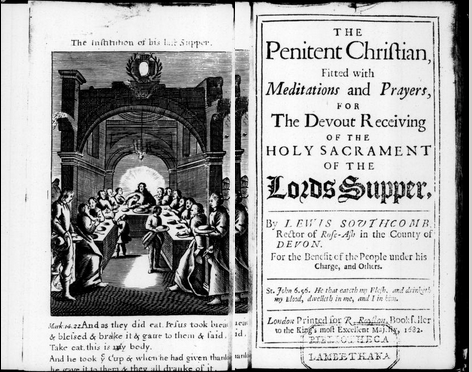
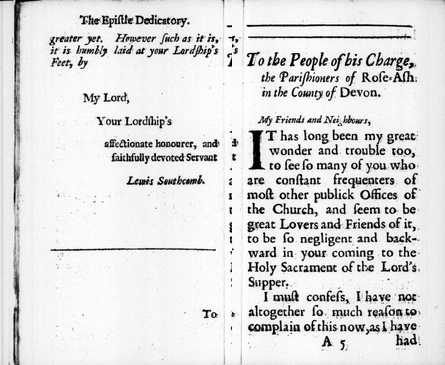
Our Previous Vicar Andrew Jones has written extensively about him.
There are Southcomb family archives held at Yale University and Devon Archives and Local Studies Service (South West Heritage Trust)

The Rose Ash Bowl
The Rose Ash Bowl was found at Munson Farm. It is made of copper and dates from 25BC to 100AD
The bowl was found high on the north side of Crooked Moor to the south of Exmoor, on the back of a long, narrow, flat-topped ridge which is part of the Middle Culm formation extending over the greater part of mid-Devon. It was discovered whilst digging a drainage channel in the corner of a marshy field with a mechanical digger. It was crumbled and damaged by the digger, but was restored by conservators at the British Museum. The bowl was found in fine grey clay, under ten to twelve inches of peat, together with many pieces of timber of oak and alder, one of which was curved. There were also marks of an upright stake 8 to 10 cm thick. Originally the bowl lay on the northern edge of a shallow pool and was probably a votive deposit.
It is unclear what the bowl was used for. The shape of its lip would make it very difficult to drink from or to pour from without spilling. It could have been used to eat food from, or for washing hands, or used at a religious ceremony. Some time after it had been made and repaired it was deliberately placed in what was then a small spring or a marsh on the hill. It was probably placed there as a religious offering.
The bowl is very similar to one found on Higher Youlton Farm near Warbstow in north Cornwall (now in the Truro Museum.). This bowl lay in black peaty soil 4.5m from a tributary of the River Ottery, 0.7m below the surface. The two bowls are almost identical in shape, but the Youlton example is slightly larger and lathe marks are plainly visible as it is undamaged. The surface of the rim has two sets of plain, lathe-turned grooves. The exterior grooves have been nicked transversley to produce a broken line effect. The Youlton escutcheon differes being cast in two pieces and is thought to represent a stylised ram's head with protuberant eye-sockets and curled horns.
Dating evidence comes from two related bowls in the Birdlip mirror burial, which can be dated from associated finds to AD 1-60.
Source: https://www.britishmuseum.org/collection/object/H_1961-1007-1
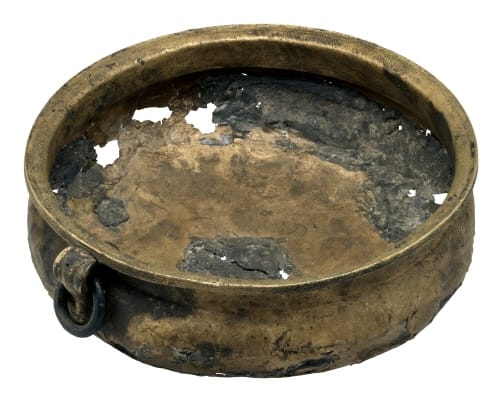
Mains Water
Many of the properties in Rose Ash were connected to mains water in 1963 (some still haven't been).

The school
ROSE ASH
Rose Ash lies on the borders of mid- and north Devon. It is an agricultural parish of some 7000-8000 acres. As with many other parishes in this general area, it had no real ‘centre’. The parish church and the manor house provided a focus for the scatter of population across some fifty farms and small-holdings.
In the mid-nineteenth century, the population peaked at about 570. Thereafter, there was a steady decline (by 25%, 1901) continuing to under 250 by the end of the twentieth century.
Rose Ash lacked a ‘lord of the manor’. The Tanner Davy family bought the Barton (= manor house) in the first half of the nineteenth century. John Tanner Davy (1828-87) was the nearest the parish had to a squire. He father was a yeoman farmer. By force of personality (he became a Lt-colonel in the N Devon militia; he was a prominent agriculturalist; a leading freemason; and a JP), he climbed the social scale.
The Southcomb rectors, who had held the living for six generations by the time John Ladavese Hamilton Southcomb became rector in 1854, were never really leaders in the parish. Their rectory lay tucked away, half a mile from the parish church. They were well-to- do, with a glebe of 100+ acres and a tithe income after 1842 of £430 (this declined significantly over the course of the century; the agricultural depression of the late 1870s bit into tithe income).
Significantly for Rose Ash, J L H Southcomb (1817-1886) and John Tanner Davy did not ‘get on’. Unusually, Southcomb, as rector, retreated, leaving the role of community leader to Tanner Davy. In the 1860s, It was John Tanner Davy who ran the National School and who, in the later 1870s, oversaw the transition to Board School.
While Rose Ash as a parish was typical of many in north Devon (and no doubt elsewhere in the county), its history in the middle years of the nineteenth century sets it apart
The school
In 1845-47, Edmund Southcomb, rector 1822-1854, established a National School on a site by the church. He gave the land (on the understanding it would revert to his successors if the school failed), and he also built an adjoining school-master’s house.
As far as I know, Southcomb received a grant from the National Society for the new building. There appears to have been no endowment. Southcomb, a bachelor, presumably, paid from his own pocket for what the school required. In the early 1850s, a school teacher was paid no more than £5 a year; so, the education was rudimentary and the cost negligible. By the 1860s, we get a glimpse of fees paid. These were entirely typical - in the range of 3d a week for farmers’ children; 2d for artisans; and 1d a week for labourers’ children.
There were parish charities. By the 1860s and ‘70s, a group had been amalgamated and a part of the income was dedicated to the support of children at the school. (In the course of the century, the Southcomb family established several charities for the poor of Rose Ash; by the
end of the century, we get a glimpse of how these were used to support the school - prizes for attendance etc).
By the 1860s, there were some half-dozen or so ‘school managers’ who assisted John Tanner Davy in financing the school. These included members of the Southcomb family (but not the rector), local clergy, and one or two local farmers. Each chipped in, with £5 here and a £1 there.
Admission and attendance
We have no hard evidence before the opening of the Board School in 1878. There was no other school in the parish. We can assume that the National School catered for both boys and girls; and that it was overwhelmingly for children from the parish.*
(A Bible-Christian congregation existed in Rose Ash, as did a Wesleyan Methodist chapel. Neither ran to a school but both ran Sunday Schools.)
- Irishcombe, in Rose Ash parish, was a detached portion of Lapford parish. Children from Irishcombe were routinely baptised at Rose Ash and, no doubt, would have gone to the school there.
Teachers
The teachers at the school were all unqualified (until the advent of the Board School). We have evidence of one male teacher and three or four female teachers. They were paid a pittance and the education they delivered was presumably pretty basic. By the mid 1870s, the school was ‘failing’.
Governance
The first insight we gain comes from the 1860s by which time John Tanner Davy had taken over the role of the rector and was running the school with the help of the ‘managers’ mentioned above. (J L H Southcomb’s diary survives for the years 1871-77; it is surely significant that it contains no reference to the school. As far as we are aware, neither he nor his wife took any active role in the school - certainly from about 1861 onwards. This is quite astonishing when placed alongside the typical Victorian clergyman, active in his school.)
So, under Tanner Davy, the school was a sort of private fiefdom.
Premises
The site given by Edmund Southcomb lay hard by the churchyard. The two buildings, school and house, abutted the ‘poor cottages’ (a kind of parish workhouse). It was these cottages which were demolished to make way for the Board School (1878). The National School then became a de facto village-hall. (Ironically, the former Board School is now the village hall.) The school-masters’ house seems to have lost this function (presumably because the new school was no longer a Church of England school). The Board School teachers lodged in the parish.
The National School buildings survive today (as two separate cottages). They were stone-built with slate roofs. They faced south so gained sunlight. All that we can now deduce is that the school was small - probably catering for a notional 30 children (but the Victorians packed them in where necessary and what evidence survives suggests that rather more than that number attended the school).
Curriculum
We have no knowledge of this prior to the Board School. No log-book survives, supposing one was kept (which is doubtful).
External relations
Again, we have no insight. In the mid-1870s, it had become clear that the National School was on its last legs and that a Board School was an inevitability. J L H Southcomb was a reluctant participant in this process, grudgingly giving the government officials the information they required (there is correspondence in his letter-book (DHC 4131) and in the NA).
Tanner Davy continued to ‘run’ the Board School until his untimely death in 1887. Thereafter, his wife Charlotte became an elected Board member.
Sources
The very scattered evidence for the National School and for the charities comes from scraps I retrieved from the church vestry and deposited in NDRO (in the Rose Ash deposit, B 678). The Board School log-book is in NDRO as is the admission-register of the school. The NA contain valuable evidence of the closure of the school in the 1870s. The Southcomb deposit (DHC 4131 is useful, especially Southcomb’s letter-book. His diaries are in the Beineke Rare Book and Manuscript Library, Yale University. I have a photo-copy of the 1871-77 volume.
NB there is no final ‘e’ in Southcomb; they were very particular about this.
https://www.devonhistorysociety.org.uk/wp-content/uploads/2023/01/Rose-Ash-School.pdf
A Dastardly Act of Arson

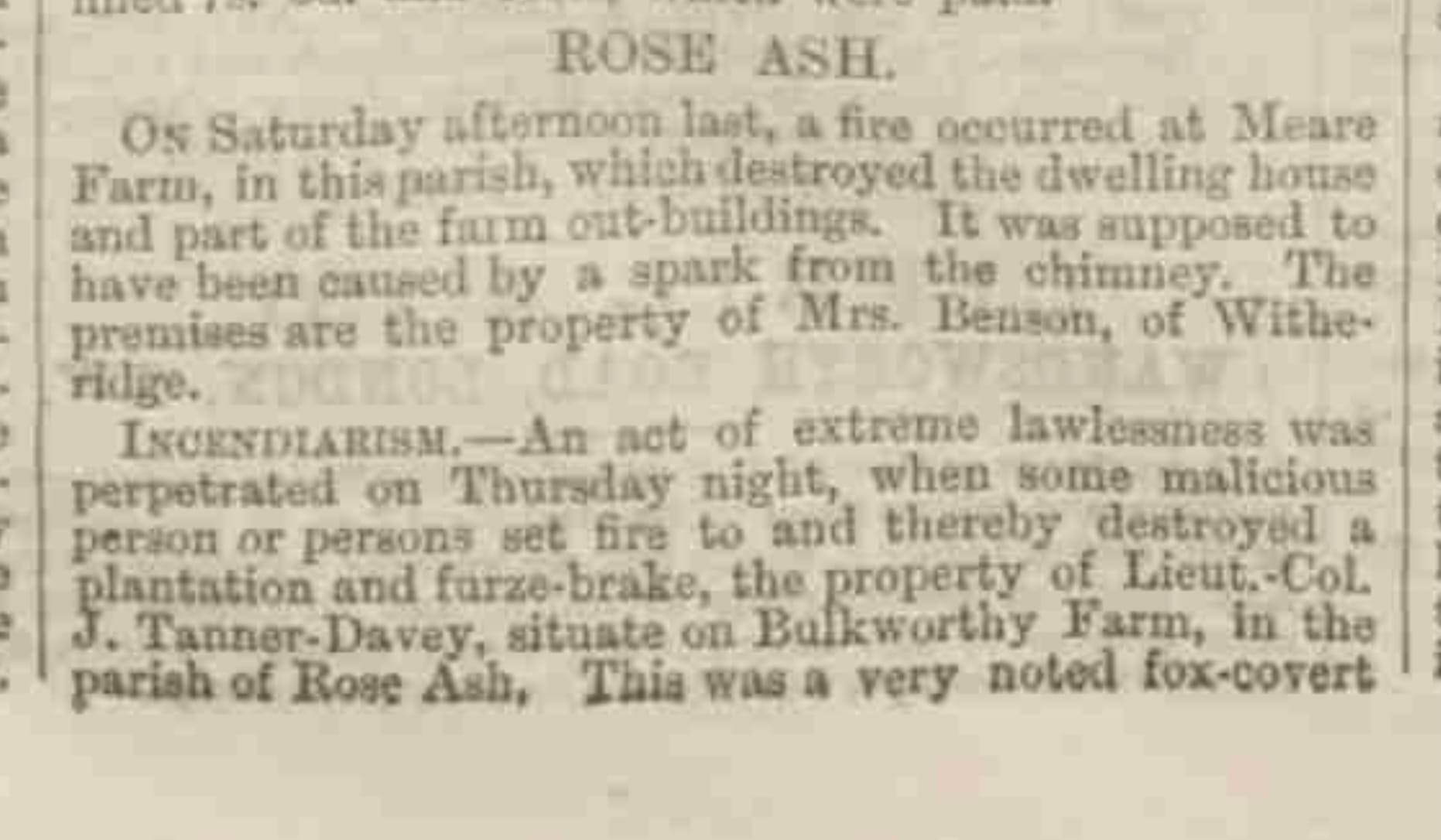

The Bench Takes a Lenient View of Illegal Rabbit Trapping at Whippenscott

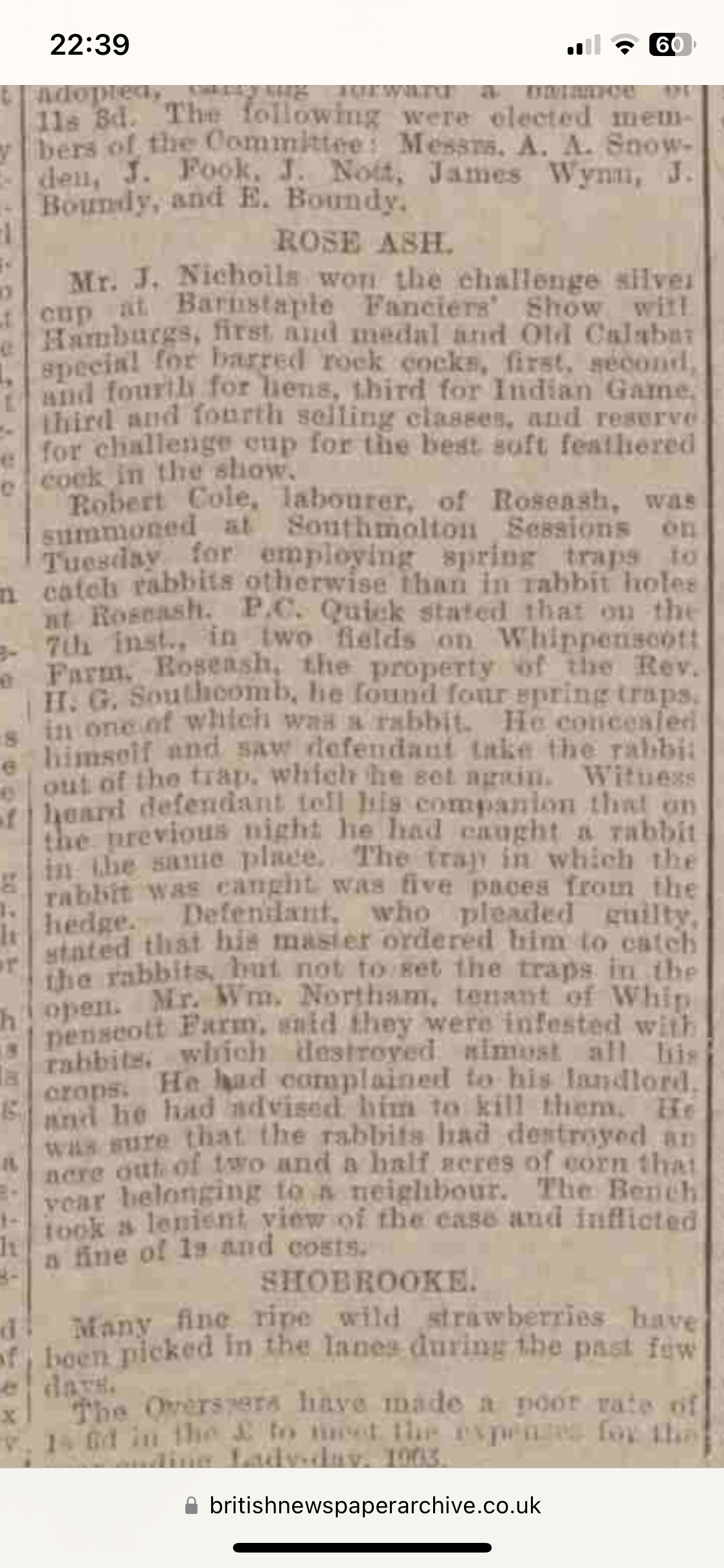
An Unlicensed Dinner Party


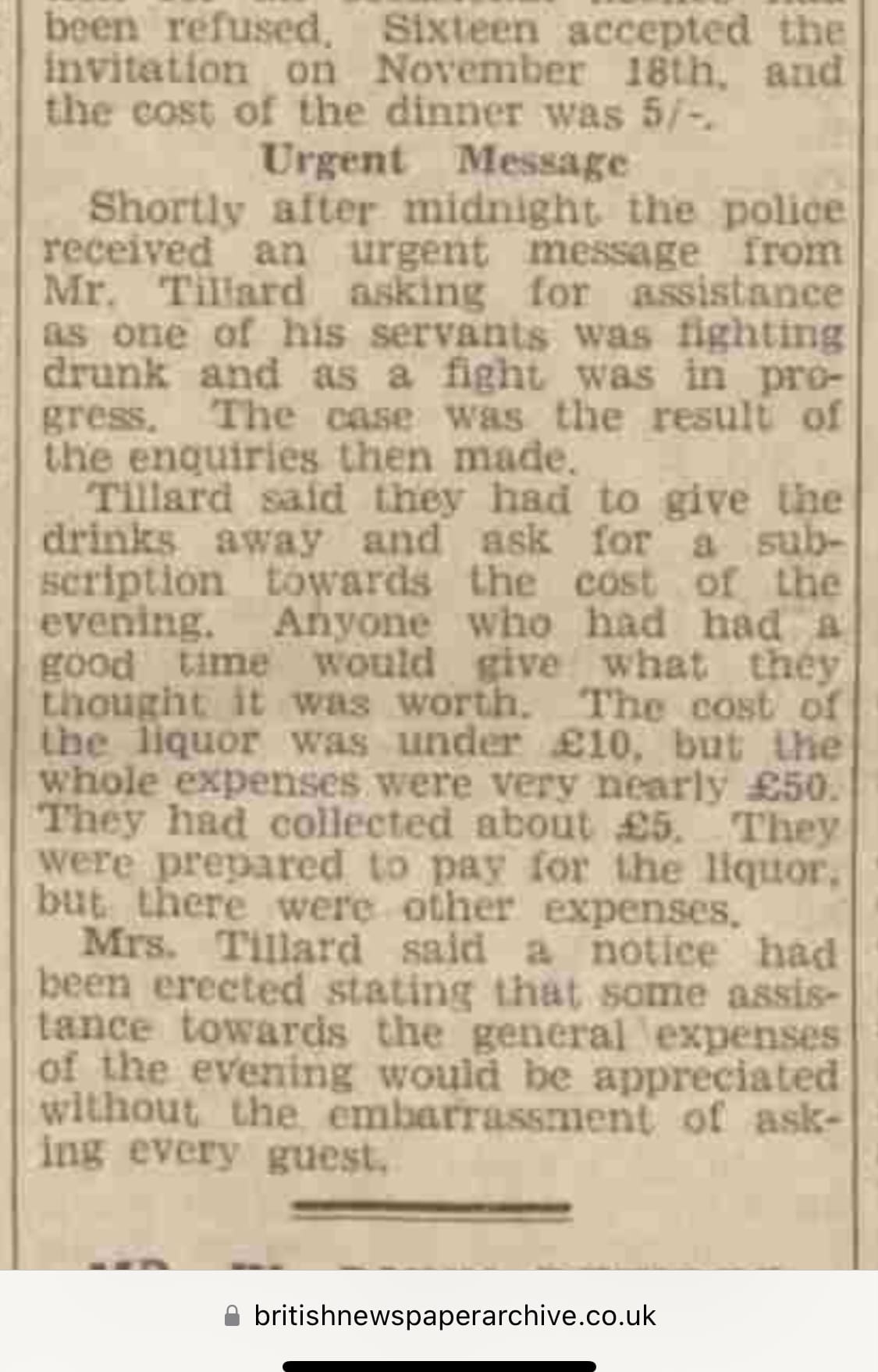
Genealogy

Community web sites
North Devon had a rich network of rural communities. Here are some of the community websites from our local area. You can find lots of information about the parishes and events.
OTHER USEFUL LINKS
LOCAL SERVICES
Library
The Amory Centre, 125 East Street, South Molton
Tel: 01769 572501
www.southmoltontowncouncil.co.uk
Household Refuse & Recycling
Refuse collection is FRIDAY - alternate weeks, Black Bin (General Rubbish) one week, Green bin (Garden Waste) the next
Recycle collection each WEDNESDAY
Recycling Centre
Maclins Quarry, South Molton, EX36 3EB
Tel: 01769 573081
HOSPITALS
North Devon District Hospital
Raleigh Park, Barnstaple
EX31 4JB
Tel: 01271 322577
South Molton Community Hospital,
Widgery Drive, South Molton
EX36 4DP
Tel: 01769 572164
www.northdevonhealth.nhs.uk
Tiverton District Hospital
Kennedy Way, Tiverton
EX16 6NT
Tel: 01884 235400
Royal Devon and Exeter,
Barrack Road, Exeter,
EX2 5DW
Tel: 01392 411611
www.rdehospital.nhs.uk
